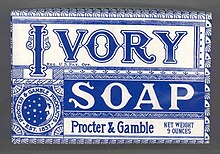
A detergent is a surfactant or a mixture of surfactants with cleansing properties when in dilute solutions. There are a large variety of detergents, a common family being the alkylbenzene sulfonates, which are soap-like compounds that are more soluble in hard water, because the polar sulfonate is less likely than the polar carboxylate to bind to calcium and other ions found in hard water.

Surfactants are chemical compounds that decrease the surface tension or interfacial tension between two liquids, a liquid and a gas, or a liquid and a solid. Surfactants may function as emulsifiers, wetting agents, detergents, foaming agents, or dispersants. The word "surfactant" is a blend of surface-active agent, coined c. 1950.
Sodium cocoate is a mixture of fatty acid salts of coconut oil that is used in some soaps.

Water softening is the removal of calcium, magnesium, and certain other metal cations in hard water. The resulting soft water requires less soap for the same cleaning effort, as soap is not wasted bonding with calcium ions. Soft water also extends the lifetime of plumbing by reducing or eliminating scale build-up in pipes and fittings. Water softening is usually achieved using lime softening or ion-exchange resins but is increasingly being accomplished using nanofiltration or reverse osmosis membranes.
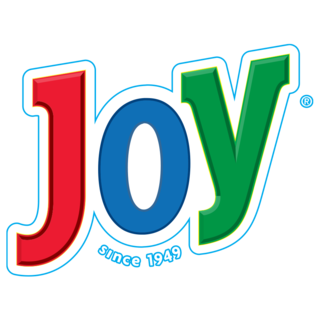
Joy is an American brand of dishwashing liquid detergent owned by JoySuds, LLC. The brand was introduced in the United States in 1949 by Procter & Gamble. In 2019, Procter & Gamble sold the rights to the Joy brand for the Americas to JoySuds, LLC.

Zest is an American brand of soap and body wash owned by High Ridge Brands for the United States, Canada and Puerto Rico and by Unilever for the rest of the world. It was originally introduced by Procter & Gamble in 1955 with the slogan "For the first time in your life, feel really clean."
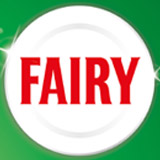
Fairy is an international brand, primarily used for washing up liquid and dishwasher detergent, owned by the American multinational consumer products company, Procter & Gamble. The brand originated in the United Kingdom in 1898 and is now used on a number of P&G products in various markets.

Ajax is a brand of household cleaning products and detergents made by Colgate-Palmolive. The brand is also licensed by Colgate-Palmolive in the United States, Canada and Puerto Rico.
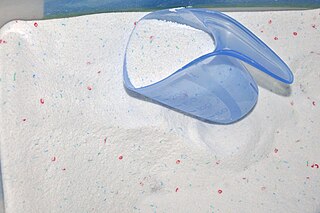
Laundry detergent is a type of detergent used for cleaning dirty laundry (clothes). Laundry detergent is manufactured in powder and liquid form.

Dishwashing liquid, also known as dishwashing soap, dish detergent, and dish soap is a detergent used to assist in dishwashing. It is usually a highly-foaming mixture of surfactants with low skin irritation, and is primarily used for hand washing of glasses, plates, cutlery, and cooking utensils in a sink or bowl. In addition to its primary use, dishwashing liquid also has various informal applications, such as for creating bubbles, clothes washing and cleaning oil-affected birds.

Shower gel is a specialized liquid product used for cleaning the body during showers. Not to be confused with liquid soaps, shower gels, in fact, do not contain saponified oil. Instead, it uses synthetic detergents derived from either petroleum or plant sources.

Tetrasodium EDTA is the salt resulting from the neutralization of ethylenediaminetetraacetic acid with four equivalents of sodium hydroxide (or an equivalent sodium base). It is a white solid that is highly soluble in water. Commercial samples are often hydrated, e.g. Na4EDTA.4H2O. The properties of solutions produced from the anhydrous and hydrated forms are the same, provided they are at the same pH.
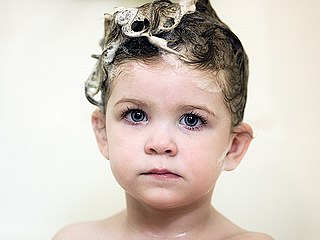
Shampoo is a hair care product, typically in the form of a viscous liquid, that is used for cleaning hair. Less commonly, shampoo is available in solid bar format. Shampoo is used by applying it to wet hair, massaging the product into the scalp, and then rinsing it out. Some users may follow a shampooing with the use of hair conditioner.
A soap substitute is a natural or synthetic cleaning product used in place of soap or other detergents, typically to reduce environmental impact or health harms or provide other benefits.

Woolite is an American brand of laundry detergent and cleaning products owned by the British multinational company Reckitt. The company acquired the Woolite brand when it bought Boyle-Midway from American Home Products / Wyeth in 1990. The company manufactures laundry accessories, among other consumer goods.

Lestoil is a registered trade name of Clorox for a heavy-duty multipurpose cleanser product, used to remove extremely difficult laundry stains, dissolve water-based and oil-based paints, and clean grease, oil, paint, and adhesives from floors and surfaces. It was introduced as a dry cleaning fluid for laundry in 1933. As a company, Lestoil, also known as the Adell Chemical Company, also made Bon Ami, from 1964 until 1971.
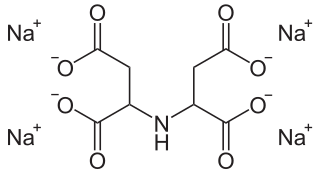
Tetrasodium iminodisuccinate is a sodium salt of iminodisuccinic acid, also referred to as N-(1,2-dicarboxyethyl)aspartic acid.
Zote is a Mexican company primarily known for its laundry soap. The soap is popular for hand washing clothes and pretreating oily stains.


